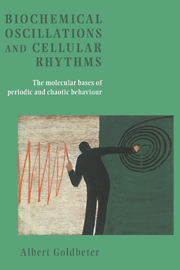Book contents
- Frontmatter
- Contents
- Foreword to the English edition by Michael Berridge
- Foreword to the French edition by Ilya Prigogin
- Preface
- 1 Introduction
- Part I Glycolytic oscillations
- Part II From simple to complex oscillatory behaviour
- Part III Oscillations of cAMP in Dictyostelium cells
- Part IV From cAMP signalling in Dictyostelium to pulsatile hormone secretion
- Part V Calcium oscillations
- Part VI The mitotic oscillator
- Part VII Circadian rhythms
- 11 Towards a model for circadian oscillations in the Drosophila period protein (PER)
- 12 Conclusions and perspectives
- References
- Index
11 - Towards a model for circadian oscillations in the Drosophila period protein (PER)
Published online by Cambridge University Press: 26 February 2010
- Frontmatter
- Contents
- Foreword to the English edition by Michael Berridge
- Foreword to the French edition by Ilya Prigogin
- Preface
- 1 Introduction
- Part I Glycolytic oscillations
- Part II From simple to complex oscillatory behaviour
- Part III Oscillations of cAMP in Dictyostelium cells
- Part IV From cAMP signalling in Dictyostelium to pulsatile hormone secretion
- Part V Calcium oscillations
- Part VI The mitotic oscillator
- Part VII Circadian rhythms
- 11 Towards a model for circadian oscillations in the Drosophila period protein (PER)
- 12 Conclusions and perspectives
- References
- Index
Summary
Circadian rhythms as ubiquitous biological clocks
Most living organisms exhibit circadian rhythms which allow them to adapt to an environment that varies with a periodicity of 24 h; such rhythms are ubiquitous and govern so many key physiological functions that they have become synonymous with biological clocks (Chovnik, 1960; Halberg, 1960; Pittendrigh, 1960, 1961; Menaker, 1971; Bunning, 1973; Aschoff, 1981; Moore-Ede et al, 1982; Edmunds, 1988). Likewise, for many, chronobiology refers specifically to the study of 24 h rhythms. In no way do we detract from the important role of circadian rhythms by stressing that such periodic phenomena comprise only one among many types of biological rhythm, besides those that have much shorter periods (see table 1.1).
Yet, circadian rhythms are of special interest because of both their prevalence among all eukaryotic organisms, unicellular or multicellular, and their immediate relevance to our human experience (Moore-Ede et al, 1982): the sleep-wake and nutrition cycles remind us every day of the fundamental, physiological role of circadian rhythms in allowing us to cope with our periodically changing environment.
Another reason why circadian rhythms remain so fascinating is that, although these rhythms have been known for so long, their mechanism remains largely unknown. The purpose of this introductory section is to present a brief overview of circadian oscillations and of the current understanding of their molecular bases, which at present is undergoing rapid progress, and to indicate how theoretical models have been used to investigate the properties of these rhythms.
- Type
- Chapter
- Information
- Biochemical Oscillations and Cellular RhythmsThe Molecular Bases of Periodic and Chaotic Behaviour, pp. 459 - 490Publisher: Cambridge University PressPrint publication year: 1996



